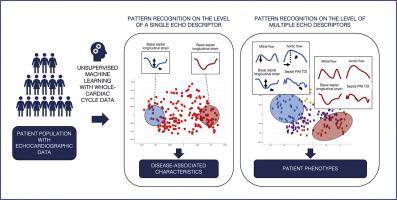Journal of the American Society of Echocardiography ( IF 6.5 ) Pub Date : 2021-07-07 , DOI: 10.1016/j.echo.2021.06.014 Filip Loncaric 1 , Pablo-Miki Marti Castellote 2 , Sergio Sanchez-Martinez 1 , Dora Fabijanovic 3 , Loredana Nunno 4 , Maria Mimbrero 4 , Laura Sanchis 4 , Adelina Doltra 4 , Silvia Montserrat 5 , Maja Cikes 3 , Fatima Crispi 6 , Gema Piella 2 , Marta Sitges 5 , Bart Bijnens 7

|
Background
Echocardiography provides complex data on cardiac function that can be integrated into patterns of dysfunction related to the severity of cardiac disease. The aim of this study was to demonstrate the feasibility of applying machine learning (ML) to automate the integration of echocardiographic data from the whole cardiac cycle and to automatically recognize patterns in velocity profiles and deformation curves, allowing the identification of functional phenotypes.
Methods
Echocardiography was performed in 189 clinically managed patients with hypertension and 97 healthy individuals without hypertension. Speckle-tracking analysis of the left ventricle and atrium was performed, and deformation curves were extracted. Aortic and mitral blood pool pulsed-wave Doppler and mitral annular tissue pulsed-wave Doppler velocity profiles were obtained. These whole–cardiac cycle deformation and velocity curves were used as ML input. Unsupervised ML was used to create a representation of patients with hypertension in a virtual space in which patients are positioned on the basis of the similarity of their integrated whole–cardiac cycle echocardiography data. Regression methods were used to explore patterns of echocardiographic traces within this virtual ML-derived space, while clustering was used to define phenogroups.
Results
The algorithm captured different patterns in tissue and blood-pool velocity and deformation profiles and integrated the findings, yielding phenotypes related to normal cardiac function and others to advanced remodeling associated with pressure overload in hypertension. The addition of individuals without hypertension into the ML-derived space confirmed the interpretation of normal and remodeled phenotypes.
Conclusions
ML-based pattern recognition is feasible from echocardiographic data obtained during the whole cardiac cycle. Automated algorithms can consistently capture patterns in velocity and deformation data and, on the basis of these patterns, group patients into interpretable, clinically comprehensive phenogroups that describe structural and functional remodeling. Automated pattern recognition may potentially aid interpretation of imaging data and diagnostic accuracy.
中文翻译:

全心循环超声心动图数据中的自动模式识别:使用机器学习捕获功能表型
背景
超声心动图提供有关心脏功能的复杂数据,可以将这些数据整合到与心脏病严重程度相关的功能障碍模式中。本研究的目的是证明应用机器学习 (ML) 来自动整合来自整个心动周期的超声心动图数据并自动识别速度剖面和变形曲线中的模式,从而识别功能表型的可行性。
方法
对 189 名经临床治疗的高血压患者和 97 名无高血压的健康人进行了超声心动图检查。对左心室和心房进行散斑跟踪分析,提取变形曲线。获得了主动脉和二尖瓣血池脉冲波多普勒和二尖瓣环组织脉冲波多普勒速度剖面。这些全心循环变形和速度曲线用作 ML 输入。无监督 ML 用于在虚拟空间中创建高血压患者的表示,在该虚拟空间中,患者根据其集成的全心脏周期超声心动图数据的相似性进行定位。回归方法用于探索该虚拟 ML 衍生空间内的超声心动图轨迹模式,而聚类用于定义表群。
结果
该算法捕获了组织和血池速度和变形曲线中的不同模式,并整合了这些发现,产生了与正常心脏功能相关的表型,以及与高血压压力超负荷相关的高级重塑的其他表型。将没有高血压的个体加入 ML 衍生空间证实了对正常和重塑表型的解释。
结论
从整个心动周期中获得的超声心动图数据中,基于 ML 的模式识别是可行的。自动化算法可以始终如一地捕捉速度和变形数据中的模式,并根据这些模式,将患者分组为描述结构和功能重塑的可解释的、临床上全面的表型组。自动模式识别可能有助于解释成像数据和诊断准确性。


























 京公网安备 11010802027423号
京公网安备 11010802027423号